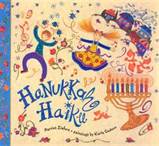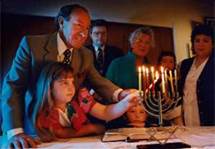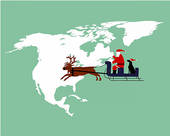
 If you are scratching your head about what to get your host parents, check out these great ideas.
If you are scratching your head about what to get your host parents, check out these great ideas.
Gift Ideas for Host Parents (from au pairs)
http://pinterest.com/aupairinamerica/gift-ideas-for-host-parents-from-au-pairs/

 If you are scratching your head about what to get your host parents, check out these great ideas.
If you are scratching your head about what to get your host parents, check out these great ideas.
Gift Ideas for Host Parents (from au pairs)
http://pinterest.com/aupairinamerica/gift-ideas-for-host-parents-from-au-pairs/
 Hanukkah started on Saturday evening and will end on Sunday, December 16th.
Hanukkah started on Saturday evening and will end on Sunday, December 16th.
Hanukkah is a Jewish holiday celebrated for eight days and nights. It starts on the 25th of the Jewish month of Kislev, which coincides with late November-late December on the secular calendar. In Hebrew, the word “hanukkah” means “dedication.” The name reminds us that this holiday commemorates the re-dedication of the holy Temple in Jerusalem following the Jewish victory over the Syrian-Greeks in 165 B.C.E.

The Hanukkah Story
In 168 B.C. the Jewish Temple was seized by Syrian-Greek soldiers and dedicated to the worship of the god Zeus. This upset the Jewish people, but many were afraid to fight back for fear of reprisals. The Syrian-Greek emperor Antiochus then made the observance of Judaism an offense punishable by death. He also ordered all Jews to worship Greek gods.
Jewish resistance began in the village of Modiin, near Jerusalem. Greek soldiers gathered the Jewish villages and told them to bow down to an idol, then eat the flesh of a pig – both practices that are forbidden to Jews. A Greek officer ordered Mattathias, a High Priest, to follow their demands, but Mattathias refused. When another villager stepped forward and offered to cooperate on Mattathias’ behalf, the High Priest became outraged. He drew his sword and killed the villager, then turned on the Greek officer and killed him too. His five sons and the other villagers then attacked the remaining soldiers, killing all of them. Mattathias and his family went into hiding in the mountains, where other Jews wishing to fight against the Greeks joined them. Eventually they succeeded in retaking their land from the Greeks. These rebels became known as the Maccabees, or Hasmoneans.
Once the Maccabees had regained control they returned to the Temple in Jerusalem. By this time it had been spiritually defiled by being used for the worship of foreign gods and also by practices such as sacrificing swine. Jewish troops were determined to purify the Temple by burning ritual oil in the Temple’s menorah for eight days. But to their dismay, they discovered that there was only one day’s worth of oil left in the Temple. They lit the menorah anyway and to their surprise the small amount of oil lasted the full eight days. The holiday is observed by the kindling of the lights of a unique candelabrum, the nine-branched Menorah, one additional light on each night of the holiday, progressing to eight on the final night. The typical Menorah consists of eight branches with an additional raised branch. The extra light is called a shamash and is given a distinct location, usually above or below the rest. The purpose of the shamash is to have a light available for use, as using the Hanukkah lights themselves is forbidden.
For fun and educational activities for children go to http://www.apples4theteacher.com/holidays/hanukkah/
Directions to play the Dreidel game. Play for Hershey kisses, a great way to have fun with the kids when they are home from school! http://www.apples4theteacher.com/holidays/hanukkah/dreidel-game.html
Happy Hanukkah!
 Reindeer Fun for you and your host children.
Reindeer Fun for you and your host children.
See Santa’s reindeer live! Live cam gives a neat look at reindeer eating and moving around in their pens. Santa comes to feed the reindeer at 11am, 6pm, and 9pm! I wonder if we will see them fly??

Diwali marks the beginning of the Hindu New Year and is celebrated with the lighting of lamps and candles, and lots of fireworks. It is regarded as one of the most important festivals of the Hindu calendar. It is celebrated across the nation with great pomp and excitement. The festival is mainly associated with lights as it is called the festival of light. The name Diwali signifies ‘rows of lighted lamps’. Diwali is a five-day festival, beginning on the 15th day of the Hindu calendar month of Kartika (Ashwin). Diyas and candles are placed on rooftops, rooms, and kitchen and even in the bathrooms. On this day, people worship Lord Ganesha, the foremost of all Hindu Gods and Goddess Lakshmi, the Goddess of Wealth and Prosperity. It is time to exchange gifts and sweets with friends, relatives and neighbors. Diwali in 2012 will start today, Tuesday, the 13th of November, and will continue for 5 days until Saturday, the 17th of November.

Take a peek at the YouTube video to learn more:

This day is a special day for all USA citizens. It is an honor to vote and one that we celebrate! Regardless of political party associations, US citizens are very proud and passionate about the ability to vote. Ask your host parents or other citizens what it means to be able to vote. I’m sure that you will have interesting and meaningful conversations to reflect on long after your au pair year ends!
The way in which people vote, depends on the state in which they live. In Oregon, all votes are cast by post and all votes have to be received at a given time on Election Day. In the state of Washington, nearly all people vote by post and the envelopes containing the voting papers have to be postmarked with the date of Election Day. In other states, people vote at voting stations, where long queues can form. Here in Georgia we go to our assigned local voting place. Many are in schools, firehouses, and community centers.
The election process is somewhat complicated here in the USA. A president must win a majority of the electoral votes not the popular vote. For simple information about the USA political system go to http://bensguide.gpo.gov/9-12/index.html
October 7-13 is Fire Safety and prevention week!
Fire Prevention Week was established to commemorate the Great Chicago Fire, the tragic 1871 conflagration that killed more than 250 people, left 100,000 homeless, destroyed more than 17,400 structures and burned more than 2,000 acres. http://www.firepreventionweek.org):
Basic fire escape planning:
Your ability to get out depends on advance warning from smoke alarms and advance planning.
Putting your plan to the test
URL: http://www.nfpa.org/itemDetail.asp?categoryID=406&itemID=17735&URL=Safety%20Information/For%20consumers/Escape%20planning/Basic%20fire%20escape%20planning
October 7-13 is Fire Safety and prevention week.
Two of the most common causes of accidental fires are related to cooking and the use of candles. Consider these tips and stay safe!
Fire Prevention Week was established to commemorate the Great Chicago Fire, the tragic 1871 conflagration that killed more than 250 people, left 100,000 homeless, destroyed more than 17,400 structures and burned more than 2,000 acres. http://www.firepreventionweek.org:
Cooking safety tips
Cooking fires are the number one cause of home fires and home injuries. The leading cause of fires in the kitchen is unattended cooking. It’s important to be alert to prevent cooking fires.
If you have a cooking fire
URL: http://www.nfpa.org/itemDetail.asp?categoryID=1695&itemID=41075&URL=Safety%20Information/For%20consumers/Causes/Cooking/Cooking%20safety%20tips
Candle safety tips
Candles may be pretty to look at but they are a cause of home fires — and home fire deaths. Remember, a candle is an open flame, which means that it can easily ignite anything that can burn.
If you do burn candles, make sure that you…
Be Ready! September is National Preparedness Month
Families should be prepared for all types of emergencies; this includes a fire, winter storm, tornado, hurricane, etc. Developing a national disaster plan is extremely important for every family to have. Having an emergency kit for the home and car is a great way to get started.
If you are at work, will your au pair be prepared? Take some time this month to discuss what you would like her to do in the event of an emergency. To find more detailed information provided by FEMA click here! We will be discussing fire safety and prevention at our cluster meeting this month.
Your emergency kit could include:
Supplies for your vehicle or the Au pair car could include:
http://www.cdc.gov/features/beready/
http://www.whattoexpect.com
Yuk It Up
Method: See a toddler tantrum coming on? Quick, Mom, tame that tantrum with fun by doing something silly! Your darling won’t stand still for a diaper change? Put the (clean) diaper on your head. He refuses to drink his milk? Pick up a banana and make a phone call. He’s losing it for no apparent reason? Climb under the table with a book. Whoever heard of Mommy reading under the table?
Why it works: Laughter releases all sorts of feel-good chemicals in the brain and stifles the stress-causing ones. The best thing about getting a toddler to giggle is that it’s not all that hard. Tots find the unexpected especially funny, so doing something outside the usual routine will more often than not distract yours long enough to diffuse his tantrum.
Method: Your toddler is screaming at the top of his lungs. Instead of trying to out-yell him, start whispering. (Tip: This will work only if he’s looking at you.)
Why it works: As soon as your toddler realizes you’re talking, he’ll probably quiet down to try to figure out why you’re using your library voice. Just make sure to be saying something soothing: “As soon as you calm down, Mommy will help you find the missing puzzle piece,” or “I’m sorry you’re so mad. Why don’t we go for a walk?” Don’t rely on this trick too often though. Your child will eventually be on to your wily, whispery ways.
Method: The next time you’re face-to-face with a toddler tantrum, try ignoring the frantic antics and carry on with what you’re doing — you can even hum or sing loudly so he really gets the message. As long as he isn’t doing anything that could be harmful to his surroundings (throwing toys) or himself (running toward the street), this can be a highly effective way to stop temper tantrums.
Why it works: Much of the drama may be a bit of an act. Yes, your toddler is legitimately frustrated, but at the same time, he also knows that when he cries or fusses he’ll be tended to: So he may use that knowledge as an attention-getting device. By now you know your child like the back of your hand, so don’t ignore him if he’s feeling especially sensitive or is going through a stressful time (his new baby sib is taking up most of your attention).
Method: It’s T-minus ten ’til dinnertime, but your toddler has his eye on the cookie jar. When you say no, he pitches a fit. Your response should be to repeat the rule, over, and over, and over: “We don’t eat cookies before dinner. We don’t eat cookies before dinner.”
Why it works: Basically, saying the same words over and over will bore the tantrum out of him. The trick is to be as consistent (don’t change any of the words) and as calm as possible. Keep your voice even and your face neutral. He’ll understand that you mean business, and see that he can’t get a rise — or a cookie — out of you before dinner.
Method: As soon as you see that temper start to rise, try to engage your wee whiner in a toddler game. That doesn’t have to mean dragging out Candy Land, but rather distracting him with a simple activity like I Spy, which works great in places like the DMV, airport, or any other place where waiting is involved.
Why it works: Playing a game works on two levels. First of all, it’s a fun distraction. Whatever is bugging your babe will likely take a backseat to the chance to have some fun with Mommy. Which is the second point: Often a tantrum is as much a cry for attention as it is a response to being frustrated or bored or angry or tired. Just be warned — timing is everything: This method works best to put the brake on a toddler tantrum if you use it just as your cutie starts to lose composure. If you wait until he’s having a full-blown screaming fit, it’ll be too tough to calm him down to play.
Method: Pick him up and hug him firmly but gently.
Why it works: When a tantrum morphs from a minor meltdown to a full-blown screaming fit, no amount of silliness or reasoning or even non-reaction on your part is going to do the trick. If he’s that upset, he won’t be able to see you or hear you, so relying on the power of your touch can be soothing, especially since losing control can be scary for a little kid. That’s why being wrapped in your loving arms can calm down a crazed critter. (Sometimes a little hug therapy is the best way of all to tame a toddler tantrum — it’ll melt any anger or frustration you have, too.)
London Olympics can be fun for au pairs and children!
Au Pair In America’s Pinterest site has a great set of ideas for au pair ‘day camps’ suitable for all ages. They are organized around various themes, such as “Under the Sea,” “Cars and Trucks,” and “Dinosaurs.” The most current one is “London Olympics,” which is a great way for families to use the cultural exchange aspect of the au pair program to see the Olympics in a whole new way. Go to http://pinterest.com/aupairinamerica to see all of the great ideas! You don’t need to be a member of Pinterest to use this link.